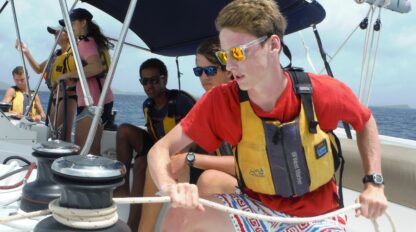Caribbean Adventures for Teens: Skin Diving

So you’ve mastered the art of snorkeling and you’re ready for a new challenge! Skin diving, also known as free diving, is an excellent way to explore things on or near the sea floor without having to don SCUBA equipment (unless you want to, of course!).
You still use the same snorkel equipment as usual (mask, snorkel, and fins), but you hold your breath as you dive beneath the surface to look around. It’s fun and easy, and there are just a few important safety considerations to keep in mind!
Be sure to review the safety and technique tips for basic snorkeling and follow the additional tips below. You’ll be on your way to exploring the underwater world in no time!
Buddy System
You should always be able to see your buddy and your buddy should always be able to see you. When on the surface, stay close enough to easily reach your buddy at all times.
Make sure you stay at the surface while your buddy is diving. Watch to make sure they are safe until they return to the surface. You can take your turn while your buddy catches his breath and keeps his eyes on you. This way, you both always have someone available to call for help right away if you need it.
Under Pressure!
If you are an experienced SCUBA diver, the action of equalizing your ears is probably almost second nature. However, if you have never attempted to dive below the surface, this will be very new and very important for you! As you dive down even just a few feet below the surface of the water the pressure increases and you will feel a slight discomfort in your ears.
The idea is to equalize, or clear, your ears early and often as gently as possible to prevent discomfort and damage to your ears. There are several ways to equalize:
- Make a yawning motion with your jaw
- Wiggle your jaw from side to side
- Swallow
- Pinch your nose through your mask and very gently try to exhale through your plugged nose
Practice clearing your ears at the surface, and continue to clear repeatedly as you dive down. You should not feel any pain or discomfort and there should not be any loud popping of your ears. If you feel any pain or discomfort, return to the surface and try diving again more slowly and clearing more often.
Be kind to your ears – if done improperly, you could seriously damage your ear drum and that is no fun at all! Most injuries occur when too much force is used to equalize (exhaling too hard against pinched nose), or by diving too deep without equalizing well enough.

How To Dive
While floating on the surface with your snorkel in your mouth, take a couple of calm, deep breaths. Hold the last breath and in a smooth motion bend at the waist so that your legs are still floating on the surface and your torso is under water. When your head is angled toward the bottom, keep your legs mostly straight and lift both fins up into the air. The motion of lifting your legs will propel you towards the bottom. Begin kicking toward the area you would like to explore and remember to equalize all the way down!
Carefully return to the surface with one hand above you and looking up in all directions to make sure you don’t surface under someone or something!
Sail Caribbean offers a variety of teen adventure camps which include expert instruction in snorkeling and skin diving techniques. You could even join one of our marine biology programs or teen scuba camps to take your explorations to the next level!

